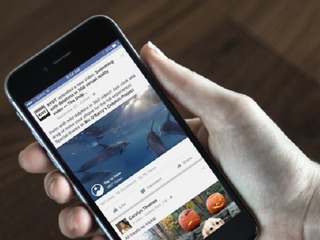
Facebook forms new team to bring virtual reality to social
The company revealed that over one million hours of VR video have been streamed on the Samsung Gear

Facebook has made it pretty well known that it sees virtual reality as a big part of its future as a company, through moves like buying Oculus and launching 360 degree videos.
On Sunday the company revealed some key stats about how that is going so far (spoiler alert: it is going well) and what the future of VR at Facebook will look like.
First the stats. The Samsung Gear VR, which is powered by Oculus, which is owned by Facebook, launched in November of last year. In just those four months or so, there are already 200 games and apps available on the platform. Even more impressive: more than a million hours of video has already been viewed in virtual reality on the device.
Those are numbers that Facebook, rightfully, should be pretty happy with, especially given how new all of this still feels. So it makes sense that the company would be working on technology to improve it, especially when it comes to video.
Facebook has already made a big bet on 360 degree videos, which allow users to view them from a variety of angles, all by simply tilting their phone. They are able to do this by shooting the video with a bunch of different cameras.
The company has already introduced 360-degree immersive video, debuted 360 video ads, while also putting them into News Feeds on iOS and introducing developer tools. Now it's introducing new technology that will " make video in virtual reality work even better." It's called "dynamic streaming," which reduces the amount of bandwidth needed, thereby quadrupling the resolution. That creat "a more efficient way" to deliver VR videos.
"To make this work, we create dozens of variants for every 360 video that gets uploaded to Facebook, each tailored to a specific viewing angle, and then as you watch the video, we rapidly adjust which variant we display based on where you’re looking," the company explained.
What that means is that, basically, it will only show what the user is look at in high quality, rather than the entire video, allowing it to load much faster.
Beyond virtual reality video, Facebook is also now looking to bring the technology to social, creating a new team dedicated to that cause.
"We’ve created a Social VR team at Facebook focused entirely on exploring the future of social interaction in VR. This team will explore how people can connect and share using today’s VR technology, as well as long-term possibilities as VR evolves into an increasingly important computing platform. They’ll will work closely with Oculus and other teams at Facebook to build the foundation for tomorrow’s social VR experiences on all platforms," the company wrote.
There already is a company bringing virtual reality to social AltSpaceVR, a company that lets people connect to virtual reality and feel like they are in the same room together. Within the world created by Altspace, users have avatars that can interact with one another, explore spaces, and generally discover virtual experiences.
AltspaceVR actually launched on the Samsung Gear earlier this month. Perhaps the company is a potential acquisition target for Facebook.
The VR/AR space
Virtual reality, and augmented reality, started to break out in 2015. Overall, AR/VR startups raised a total of $658 million in equity financing in 2015, across 126 deals, down from $771 million across 52 deals in 2014. It should be noted that amount raised in 2014 was inflated by a single investment, however, when Magic Leap raised $542 million round. That single investment totaled more than 82 percent of all the money raised that year.
If you were wondering what the difference is between the two, VR is closed and fully immersive, while AR is open and partly immersive. Where VR puts users inside virtual worlds, immersing them, AR puts virtual things into users’ real worlds, augmenting them. Basically VR is something you wear on your face, like Oculus VR, while AR is like wearing something along the lines of Google Glass, where you will still be able to walk around and see the real world around you.
The two spaces, together, are expected to be worth $150 million by 2020, up from what looks to be around $5 billion in 2016.
With that kind of money pouring in, it makes sense for Facebook to try to be on the cutting edge, unlike its failure to launch its own mobile operating system.
"If you look at how people spend time on all computing platforms, whether it’s phones or desktops before that, about 40% is spent on some kind of communications and media," Mark Zuckerberg said in aninterview last year.
"Over the long term, when [Oculus] becomes a more mature platform, I would bet that it’s going to be that same 40% of the time spent doing social interactions and things like that. And that’s what we know. That’s what we can do."
In addition to virtual reality, Oculus is also said to be working on augmented reality. If the company can dominate both segments, then Zuckerberg said believes that the Rift, the Oculus headset that is set to be launched in March, "could be the last electronics device that a lot of people need to buy."
(Image source: augmentedrealitytrends.com)
Related News


Mark Zuckerberg talks Facebook's vision, its big bet on VR

Facebook working on app dedicated to 360 degree videos

Facebook goes all in on 360-degree videos

AR and VR startups raise $658M in 126 deals in 2015

This year Mark Zuckerberg wants to build his own JARVIS

